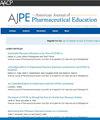Impact of COVID-19 on Scholarly Outcomes of Pharmacy Practice Faculty by Gender and Academic Rank
IF 3.5
4区 教育学
Q1 EDUCATION, SCIENTIFIC DISCIPLINES
引用次数: 0
Abstract
Objective
To determine how the COVID-19 pandemic impacted the scholarly outcomes of pharmacy practice faculty, and whether the impact varied by gender and academic rank.
Methods
Pharmacy practice faculty from the top 50 NIH-funded schools of pharmacy (2018-2021) were included. Faculty whose gender was indeterminable with Gender API or who has no Scopus record were excluded. Publications before and during the pandemic (2018-2019 and 2020-2021, respectively) were obtained from Scopus. Primary outcomes included scholarly activity (probability of publishing) and scholarly output (number of documents published). Secondary outcomes were fractional scholarly output (FSO) and collaboration coefficient (CC). Data was analyzed using generalized linear mixed-effects models, with fixed effects including pandemic, rank, and gender. Interaction effects were only included in final models if statistically significant.
Results
Faculty included were 1081 (61.2% women; 31.4%, 40.0%, and 28.7% assistant, associate, and professors, respectively). Unique documents published increased from 2428 to 2737 during the pandemic. There was a significant pandemic-rank interaction in scholarly activity, while scholarly output had both pandemic-rank and pandemic-gender interactions. Men had higher scholarly output versus women across all ranks, in both periods. During the pandemic, scholarly output increased among all assistants and associates, but among professors, men had no change, while women had a decrease.
Conclusion
The pandemic effect on pharmacy practice faculty scholarly outcomes varied across gender and academic ranks. Institutions should implement initiatives to mitigate the extant gender gap in scholarly output that persisted during the pandemic, as it may impact career progression, tenure prospects, and retention.
COVID-19对按性别和学术排名的药学实践教师学术成果的影响。
目的:了解2019冠状病毒病大流行对药学实习教师学术成果的影响,以及这种影响是否因性别和学术等级而异。方法:纳入美国国立卫生研究院资助的前50所药学院(2018-2021)的药学实践教师。性别API无法确定或没有Scopus记录的教师被排除在外。大流行之前和期间(分别为2018-2019年和2020-2021年)的出版物来自Scopus。主要结果包括学术活动(发表的概率)和学术产出(发表的文献数量)。次要结果是分数学术产出(FSO)和合作系数(CC)。使用广义线性混合效应模型分析数据,固定效应包括流行病、级别和性别。只有在统计上显著的情况下,相互作用效应才包括在最终模型中。结果:纳入教职工1081人(女性61.2%;助理(31.4%)、副教授(40.0%)、教授(28.7%)。大流行期间发表的独特文件从2428份增加到2737份。在学术活动中存在显著的流行病与等级的相互作用,而学术产出既存在流行病与等级的相互作用,也存在流行病与性别的相互作用。在这两个时期,男性在各阶层的学术产出都高于女性。在大流行期间,所有助理和助理的学术产出都有所增加,但在教授中,男性没有变化,而女性有所减少。结论:大流行对药学实习教师学术成果的影响在性别和学术等级上存在差异。各院校应采取措施,缩小疫情期间持续存在的学术产出方面的性别差距,因为这可能影响职业发展、终身任职前景和留用。
本文章由计算机程序翻译,如有差异,请以英文原文为准。
求助全文
约1分钟内获得全文
求助全文
来源期刊
CiteScore
4.30
自引率
15.20%
发文量
114
期刊介绍:
The Journal accepts unsolicited manuscripts that have not been published and are not under consideration for publication elsewhere. The Journal only considers material related to pharmaceutical education for publication. Authors must prepare manuscripts to conform to the Journal style (Author Instructions). All manuscripts are subject to peer review and approval by the editor prior to acceptance for publication. Reviewers are assigned by the editor with the advice of the editorial board as needed. Manuscripts are submitted and processed online (Submit a Manuscript) using Editorial Manager, an online manuscript tracking system that facilitates communication between the editorial office, editor, associate editors, reviewers, and authors.
After a manuscript is accepted, it is scheduled for publication in an upcoming issue of the Journal. All manuscripts are formatted and copyedited, and returned to the author for review and approval of the changes. Approximately 2 weeks prior to publication, the author receives an electronic proof of the article for final review and approval. Authors are not assessed page charges for publication.

 求助内容:
求助内容: 应助结果提醒方式:
应助结果提醒方式:


